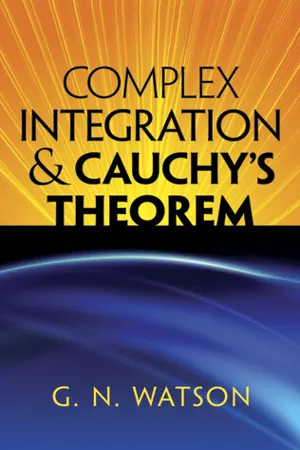
This is a test
- 96 pages
- English
- ePUB (mobile friendly)
- Available on iOS & Android
eBook - ePub
Complex Integration and Cauchy's Theorem
Book details
Book preview
Table of contents
Citations
About This Book
This brief monograph by one of the great mathematicians of the early twentieth century offers a single-volume compilation of propositions employed in proofs of Cauchy's theorem. Developing an arithmetical basis that avoids geometrical intuitions, Watson also provides a brief account of the various applications of the theorem to the evaluation of definite integrals.
Author G. N. Watson begins by reviewing various propositions of Poincaré's Analysis Situs, upon which proof of the theorem's most general form depends. Subsequent chapters examine the calculus of residues, calculus optimization, the evaluation of definite integrals, and expansions in series. A historical summary concludes the text, which is supplemented by numerous challenging exercises.
Author G. N. Watson begins by reviewing various propositions of Poincaré's Analysis Situs, upon which proof of the theorem's most general form depends. Subsequent chapters examine the calculus of residues, calculus optimization, the evaluation of definite integrals, and expansions in series. A historical summary concludes the text, which is supplemented by numerous challenging exercises.
Frequently asked questions
At the moment all of our mobile-responsive ePub books are available to download via the app. Most of our PDFs are also available to download and we're working on making the final remaining ones downloadable now. Learn more here.
Both plans give you full access to the library and all of Perlego’s features. The only differences are the price and subscription period: With the annual plan you’ll save around 30% compared to 12 months on the monthly plan.
We are an online textbook subscription service, where you can get access to an entire online library for less than the price of a single book per month. With over 1 million books across 1000+ topics, we’ve got you covered! Learn more here.
Look out for the read-aloud symbol on your next book to see if you can listen to it. The read-aloud tool reads text aloud for you, highlighting the text as it is being read. You can pause it, speed it up and slow it down. Learn more here.
Yes, you can access Complex Integration and Cauchy's Theorem by G.N. Watson in PDF and/or ePUB format, as well as other popular books in Matematica & Analisi funzionale. We have over one million books available in our catalogue for you to explore.
Information
Topic
MatematicaSubtopic
Analisi funzionaleCHAPTER I
ANALYSIS SITUS
§ 3. Problems of Analysis situs to be discussed.—§ 4. Definitions.—§ 5. Properties of continua.—§ 6. Theorems concerning the order of a point.—§ 7. Main theorem; a regular closed curve has an interior and an exterior.—§ 8. Miscellaneous theorems; definitions of counterclockwise and orientation.
3. The object of the present chapter is to give formal analytical proofs of various theorems of which simple cases seem more or less obvious from geometrical considerations. It is convenient to summarise, for purposes of reference, the general course of the theorems which will be proved:
A simple curve is determined by the equations x = x(t), y = y(t) (where t varies from t0 to T), the functions x(t), y(t) being continuous; and the curve has no double points save (possibly) its end points; if these coincide, the curve is said to be closed. The order of a point Q with respect to a closed curve is defined to be n, where 2πn is the amount by which the angle between QP and Ox increases as P describes the curve once. It is then shewn that points in the plane, not on the curve, can be divided into two sets; points of the first set have order ±1 with respect to the curve, points of the second set have order zero; the first set is called the interior of the curve, and the second the exterior. It is shewn that every simple curve joining an interior point to an exterior point must meet the given curve, but that simple curves can be drawn, joining any two interior points (or exterior points), which have no point in common with the given curve. It is, of course, not obvious that a closed curve (defined as a curve with coincident end points) divides the plane into two regions possessing these properties.
It is then possible to distinguish the direction in which P describes the curve (viz. counterclockwise or clockwise); the criterion which determines the direction is the sign of the order of an interior point.
The investigation just summarised is that due to Ames1; the analysis which will be given follows his memoir closely. Other proofs that a closed curve possesses an interior and an exterior have been given by Jordan2, Schoenflies3, Bliss4, and de la Vallée Poussin5. It has been pointed out that Jordan’s proof is incomplete, as it assumes that the theorem is true for closed polygons; the other proofs m...
Table of contents
- Cover Page
- Title Page
- Copyright Page
- Preface
- Contents
- INTRODUCTION
- CHAPTER I. ANALYSIS SITUS
- CHAPTER II. COMPLEX INTEGRATION
- CHAPTER III. CAUCHY’S THEOREM
- CHAPTER IV. MISCELLANEOUS THEOREMS
- CHAPTER V. THE CALCULUS OF RESIDUES
- CHAPTER VI. THE EVALUATION OF DEFINITE INTEGRALS
- CHAPTER VII. EXPANSIONS IN SERIES
- CHAPTER VIII. HISTORICAL SUMMARY
- Back Cover